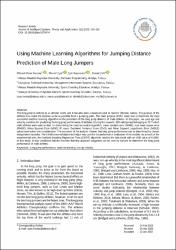| dc.contributor.author | İncetaş, Mürsel Ozan | |
| dc.contributor.author | Uçar, Murat | |
| dc.contributor.author | Bayraktar, Işık | |
| dc.contributor.author | Çilli, Murat | |
| dc.date.accessioned | 2022-12-23T12:22:42Z | |
| dc.date.available | 2022-12-23T12:22:42Z | |
| dc.date.issued | 2022 | en_US |
| dc.identifier.citation | Uçar, M., İncetaş, M. O., Bayraktar, I. & Çilli, M. (2022). Using Machine Learning Algorithms for Jumping Distance Prediction of Male Long Jumpers . Journal of Intelligent Systems: Theory and Applications, 5 (2), 145-152.
https://doi.org/10.38016/jista.1078474 | en_US |
| dc.identifier.uri | https://doi.org/10.38016/jista.1078474 | |
| dc.identifier.uri | https://dergipark.org.tr/tr/pub/jista/issue/70283/1078474 | |
| dc.identifier.uri | https://hdl.handle.net/20.500.12508/2462 | |
| dc.description.abstract | The long jump is defined as an athletic event, and it has also been a standard event in modern Olympic Games. The purpose of the athletes is to make the distance as far as possible from a jumping point. The main purpose of this study was to determine the most successful machine learning algorithm in the prediction of the long jump distance of male athletes. In this paper, we used age and velocity variables for predicting the long jump performance of athletes. During the research, 328 valid jumps belonging to 73 Turkish male athletes were used as data. In determining the most successful algorithm, mean absolute error (MAE), root mean square error (RMSE), Mean Squared Error (MSE), R2 score, Explained Variance Score (EVS), and Mean Squared Logarithmic Error (MSLE) values were taken into consideration. The outcomes of the analysis showed that long jump performance can be determined by chosen independent variables. The 5-fold cross-validation technique was used for the performance evaluation of the models. As a result of the experimental tests, the Gradient Boosting Regression Trees (GBRT) algorithm reached the best result with an MSE value of 0.0865. In this study, it was concluded that the machine learning approach suggested can be used by trainers to determine the long jump performance of male athletes. | en_US |
| dc.language.iso | eng | en_US |
| dc.publisher | Journal of Intelligent Systems: Theory and Applications | en_US |
| dc.relation.isversionof | 10.38016/jista.1078474 | en_US |
| dc.rights | info:eu-repo/semantics/openAccess | en_US |
| dc.subject | Long jump performance | en_US |
| dc.subject | Machine learning | en_US |
| dc.subject | Run-up velocity | en_US |
| dc.title | Using Machine Learning Algorithms for Jumping Distance Prediction of Male Long Jumpers | en_US |
| dc.type | article | en_US |
| dc.relation.journal | Journal of Intelligent Systems: Theory and Applications | en_US |
| dc.contributor.department | İşletme ve Yönetim Bilimleri Fakültesi -- Yönetim Bilişim Sistemleri Bölümü | en_US |
| dc.identifier.volume | 5 | en_US |
| dc.identifier.issue | 2 | en_US |
| dc.identifier.startpage | 145 | en_US |
| dc.identifier.endpage | 152 | en_US |
| dc.relation.publicationcategory | Makale - Ulusal Hakemli Dergi - Kurum Öğretim Elemanı | en_US |
| dc.contributor.isteauthor | Uçar, Murat | |
| dc.relation.index | TR-Dizin | en_US |
















